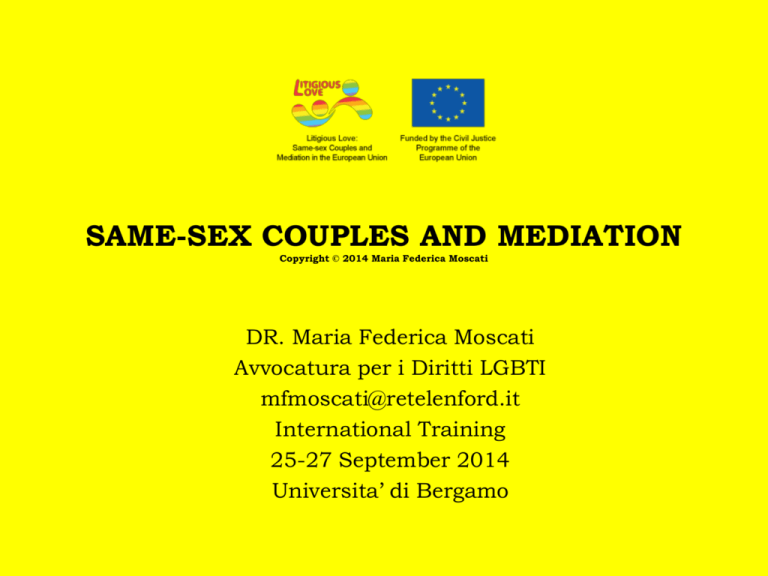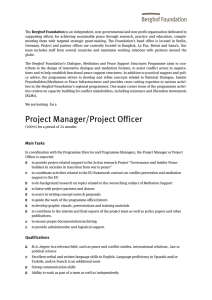
SAME-SEX COUPLES AND MEDIATION
Copyright © 2014 Maria Federica Moscati
DR. Maria Federica Moscati
Avvocatura per i Diritti LGBTI
mfmoscati@retelenford.it
International Training
25-27 September 2014
Universita’ di Bergamo
Copyright © 2014 Marica Moscati
All rights reserved.
Maria Federica Moscati has asserted her right
to be identified as the authors of this work and
thus assert their moral rights in accordance with
the Copyright, Designs and Patents Act 1988
Copyright © 2014 MARIA FEDERICA
MOSCATI
AIMS
• We provide a general overview of the social and legal
background inspiring and motivating same-sex couples to
mediate their disputes.
• We address the following questions:
• What are the reasons of the emergence of mediation in the
LGBT (that is, Lesbian, Gay, Bisexual, Trans-sexual)
community?
• What are the sources of disputes between same-sex partners?
Copyright © 2014 MARIA FEDERICA
MOSCATI
AIMS
• What are the frequent issues that arise during mediation?
• How can the mediator, the lawyer and the judge better deal
with mediation in same-sex disputes?
• Work in progress
• Handbook
• Your contribution is essential!
• Something to consider: judges, lawyers, mediators all
together here!
Copyright © 2014 MARIA FEDERICA
MOSCATI
STRUCTURE
• Introduction
• Causes of dispute between same-sex partners
• Dispute resolution mechanisms adopted by same-sex couples
• Judges, lawyers and mediators
• Before mediation: is mediation suitable?
Copyright © 2014 MARIA FEDERICA
MOSCATI
STRUCTURE
• During mediation:
How to deal with specific issues: Power Imbalances,
stereotypes, domestic violence
How to deal with specific issues: Understanding the new legal
and social framework
How to deal with specific issues: language
Copyright © 2014 MARIA FEDERICA
MOSCATI
STRUCTURE
• After mediation: putting the agreement into effect
• Focus on Parenting Disputes
• Reflections
• Case studies
Copyright © 2014 MARIA FEDERICA
MOSCATI
INTRODUCTION
• Same-Sex Partners Argue!!!
• Limited data and resources
• Presentation derived from the author’s empirical research:
thank to all mediators and lawyers who agreed to interview
• Mediation used since 1970s by LGBT community
• Mediation as the only alternative to court for same-sex
couples
Copyright © 2014 MARIA FEDERICA
MOSCATI
INTRODUCTION
• Changes since 1970s: differences depending on countries and
time
• Reasons for choosing mediation:
No Legal Recognition of Same-Sex Unions
Stereotypes and ostensibly homophobic judicial decisions:
Homosexual behaviour in general
Homophobic decisions in child custody cases
Hostility by court officials and lawyers
Copyright © 2014 MARIA FEDERICA
MOSCATI
INTRODUCTION
• Advantages of Mediation:
Less formal; inexpensive and speedy service; creative
Protection from discrimination; Protection of Privacy
Protection of children
Empowerment of LGBT community
Copyright © 2014 MARIA FEDERICA
MOSCATI
INTRODUCTION
• From field-work:
“We need to come to an agreement that A respects our nuclear
family”
“I would like to avoid another court hearing. He has refused to
comply with the contact order of the court”
“I am here because she has asked me”
“We are not married, why should we use mediation?”
Copyright © 2014 MARIA FEDERICA
MOSCATI
INTRODUCTION
• Current emphasis on mediation
• Legal framework: The Directive of the European Parliament
and of the European Council of 21 May 2008 on Certain
Aspects Of Mediation In Civil And Commercial Matters
(2008/52)
• Different legal consideration in domestic law
• Use of mediation for national, and trans-national family
disputes: international child abduction
Copyright © 2014 MARIA FEDERICA
MOSCATI
INTRODUCTION
• Focused reading:
• MOSCATI, Maria Federica (2014) ‘Same-Sex Couples and
Mediation: A practical Handbook’, available at
www.litigiouslove.eu
• HANSON, Mark J. (2006) ‘Moving Forward Together: the
LGBT Community and the Family Mediation Field’,
Pepperdine Dispute Resolution Law Journal, Vol. 7, pp.295312.
Copyright © 2014 MARIA FEDERICA
MOSCATI
CAUSES OF DISPUTE
• Not all sources of disputes represent reasons of break up:
main reason for break up is just falling apart
• Finance
• Children
• Abuses
• Drug
• Open-relationship
• Inheritance
Copyright © 2014 MARIA FEDERICA
MOSCATI
CAUSES OF DISPUTE
•Changes depending on legal recognition and social acceptance
of same-sex couples: coming out; false expectations; HIV/AIDS;
internalising social disapproval
•Differences between same-sex couples and heterosexual
couples; differences between gay couples and lesbian
couples….if any
Copyright © 2014 MARIA FEDERICA
MOSCATI
CAUSES OF DISPUTE
Focused reading:
•ASTOR, Hilary (1995-96) ‘Mediation of Intra-Lesbian Disputes’,
Melbourne University Law Review, Vo.20, pp.953-978.
•MOSCATI, Maria Federica (2014) ‘Same-Sex Couples and
Mediation: A practical Handbook’, available at
www.litigiouslove.eu
•Mc INTYRE, Douglas (1994) ‘Gay Parents and Child Custody: a
Struggle under the Legal System’, Mediation Quarterly, Vol.12,
pp.135-149.
•MOSCATI, Maria Federica (2014) ‘Introduction’ and ‘Fitting the
Forum to the Fuss’ in her Pasolini’s Italian Premonitions: SameSex Couples and the Law in Comparative Perspective, London:
Wildy, Simmonds & Hill Publishing.
Copyright © 2014 MARIA FEDERICA
MOSCATI
DISPUTE RESOLUTION MECHANISMS USED
BY SAME-SEX COUPLES
•
Mediation
• Negotiation by lawyers
• Therapy
• Family Conference
• Counselling
• Community-based mediation: San Francisco Community
Board
Copyright © 2014 MARIA FEDERICA
MOSCATI
DISPUTE RESOLUTION MECHANISMS USED
BY SAME-SEX COUPLES
• Collaborative law
• Using different mechanisms before attempting mediation
•
Mediation for preventing disputes: creating pre-nuptial, and
post-nuptial agreements
Copyright © 2014 MARIA FEDERICA
MOSCATI
DISPUTE RESOLUTION MECHANISMS USED
BY SAME-SEX COUPLES
Focused reading:
• FRESHMAN, Clark (1996-97) ‘Privatizing Same-Sex Marriage
through Alternative Dispute Resolution: CommunityEnhancing versus Community-Enabling Mediation’, UCLA
Law Review, Vol.44, pp.1687-1772.
• MOSCATI, Maria Federica (2014) ‘Same-Sex Couples and
Mediation: A practical Handbook’, available at
www.litigiouslove.eu
• MOSCATI, Maria Federica (2014) ‘Introduction’ and ‘Fitting
the Forum to the Fuss’ in her Pasolini’s Italian Premonitions:
Same-Sex Couples and the Law in Comparative Perspective,
London: Wildy, Simmonds & Hill Publishing.
Copyright © 2014 MARIA FEDERICA
MOSCATI
JUDGES, LAWYERS AND MEDIATORS
•
All play important roles!
• Cooperation…even if we know that we do different things!
• Common: HAVE AN OPEN MIND; RESPECT; LISTEN TO…
Copyright © 2014 MARIA FEDERICA
MOSCATI
JUDGES, LAWYERS AND MEDIATORS
• Common:
be honest about your bias
be honest about your sexual orientation
learn about LGBT culture
understanding the new legal framework (national, foreign,
and international)
should be gay or lesbian?
inform clients
Copyright © 2014 MARIA FEDERICA
MOSCATI
JUDGES, LAWYERS AND MEDIATORS
• Common:
consider children
don’t push disputants to mediation
attention to language
listen to disputants and all parties involved
use material (such as referral form) respectful of the same
gender of the parties
Copyright © 2014 MARIA FEDERICA
MOSCATI
JUDGES, LAWYERS AND MEDIATORS
•
Judges: suggestion and not decision; liaise with lawyers and
mediators
• Lawyers: it’s not a court case, and it’s not purely legal;
precise information; listen to clients
• Mediators: facilitate communication; impartial; building
trust; creating an environment for the parties to feel
comfortable and keen to talk; establishing ground rules;
considering all issues (including coming out); helping parties
to understand underlying issues; balancing power; helping
the communication; ensure confidentiality
Copyright © 2014 MARIA FEDERICA
MOSCATI
BEFORE MEDIATION: IS MEDIATIOIN
SUITABLE?
• Is the right time to mediate?
• Free and well-informed choice of the parties
• Screening procedure
• When mediation is not suitable: power imbalances; domestic
violence; extreme conflict; involuntary participation;
unsuitability of dispute
Copyright © 2014 MARIA FEDERICA
MOSCATI
BEFORE MEDIATION: IS MEDIATIOIN
SUITABLE?
• Who does what:
lawyers (inform clients about different models of dispute
resolution; and liaise with mediators)
judges (inform parties about mediation and other available
mechanisms)
mediators (screening test; inform disputants about number of
meetings; expenses; who will participate; who is the mediator
and whether co-mediation could be a possibility; try to
understand whether disputants are ready for mediation)
Copyright © 2014 MARIA FEDERICA
MOSCATI
BEFORE MEDIATION: IS MEDIATIOIN
SUITABLE?
•
Disadvantages of mediation:
Lack of knowledge
Issues not analysed fully
Manipulation: mediator can manipulate the parties; one party
can manipulate the other party
Pressure from the community: harmony
A new closet
Copyright © 2014 MARIA FEDERICA
MOSCATI
BEFORE MEDIATION: IS MEDIATIOIN
SUITABLE?
Focused reading:
•MOSCATI, Maria Federica (2014) ‘Same-Sex Couples and
Mediation: A practical Handbook’, available at
www.litigiouslove.eu
•ROBERTS, Marian (2008) Mediation in Family Disputes.
Principle of Practice, Aldershot: Ashgate Publishing Limited.
Copyright © 2014 MARIA FEDERICA
MOSCATI
DURING MEDIATION
•
Disputes and dispute resolution do not occur in a vacuum
• Understanding disputants and context….influence from
personal and social factors
• Gulliver: “mediation serves a negotiation process; the role of
the mediator is understandable only within an understanding
of that process” (Gulliver, 1977; Roberts, 2007)
• Fuller: “the central quality of the mediation is its capacity to
reorient the parties towards each other” (Fuller, 1971)
Copyright © 2014 MARIA FEDERICA
MOSCATI
DURING MEDIATION
•
Successful mediation:
respect
impartiality
precise information
voluntary process
confidentiality
all important issues for the parties have been dealt with
Copyright © 2014 MARIA FEDERICA
MOSCATI
DURING MEDIATION
agreement respectful of ideas and wishes of all parties
involved
agreement according to law
children involved if they wish
summary after each meeting
• In few words: “achieving a new and shared perception of their
relationship” (Fuller, 1971: 305).
Copyright © 2014 MARIA FEDERICA
MOSCATI
DURING MEDIATION
• Models of practice: variety of arrangement; pre-mediation;
joint session; caucus…combination of all
• Different countries…different models
• Co-mediation: two mediators; lawyer and mediator
• Lawyers and other professionals can be involved for technical
advices
Copyright © 2014 MARIA FEDERICA
MOSCATI
DURING MEDIATION
•
From field-work: example of good practice:
“Dear Anthony and Frank/Anne and Leila, thank you for
attending mediation with me. I agreed to summarise the main
points in a letter to you all…..The letter does not record or
create a binding agreement between you. It is intended to
facilitate each of you…”
“Dear Anthony and Frank/ Anne and Leila, given the
transparent nature of mediation I thought it might be helpful
for me to write to you all concerning our next proposed
mediation meeting.”
Copyright © 2014 MARIA FEDERICA
MOSCATI
DURING MEDIATION
•
From field-work: example of good practice:
“It is my intention, as mediator to create a respectful, child
centric arena where parents and those involved in relation to
particular young person can discuss matters in the hope of
reaching decisions about arrangements and behaviours
which promote the well-being of the children.”
“I am sorry that our meeting today and mediation more
generally has not been more productive for you. Naturally you
have your different positions and it has always been difficult
for mediation bridge the gap.”
Copyright © 2014 MARIA FEDERICA
MOSCATI
DURING MEDIATION
Focused reading:
•FULLER, Lon (1971) ‘Mediation its forms and functions’,
Southern California Law Review, Vol. 44, pp. 309-339.
•MOSCATI, Maria Federica (2014) ‘Same-Sex Couples and
Mediation: A practical Handbook’, available at
www.litigiouslove.eu
•HERTZ, Frederick, WALD, Deborah & Stacey, SHUSTER (2009)
‘Integrated Approaches to Resolving Same-Sex Dissolutions’,
Conflict Resolution Quarterly, Vol.27, No.2, Winter 2009, pp.123143.
Copyright © 2014 MARIA FEDERICA
MOSCATI
DURING MEDIATION
Focused reading:
•GULLIVER, Philip (1977) ‘On Mediation’, in I. Hamnett (ed)
Social Anthropology and the Law, London: Academic Press
•ROBERTS, Marian (2007) Developing the Craft of Mediation.
Reflection on Theory and Practice, London, and Philadelphia:
Jessica Kingsley Publishers.
Copyright © 2014 MARIA FEDERICA
MOSCATI
POWER IMBALANCES, STEREOTYPES AND
DOMESTIC VIOLENCE
• Is mediation dangerous for same-sex partners?
• Sources of power imbalances; age; financial situation;
biological tie with the children
• Managing power imbalances
• Nature of stereotype; educating parties and educating the
mediator; importance of differences as resource
Copyright © 2014 MARIA FEDERICA
MOSCATI
POWER IMBALANCES, STEREOTYPES AND
DOMESTIC VIOLENCE
• Domestic violence: causes of domestic violence
• Mediation not suitable for mediation; screening; stop
mediation; training for mediators
Copyright © 2014 MARIA FEDERICA
MOSCATI
POWER IMBALANCES, STEREOTYPES AND
DOMESTIC VIOLENCE
Focused reading:
•MOSCATI, Maria Federica (2014) ‘Same-Sex Couples and
Mediation: A practical Handbook’, available at
www.litigiouslove.eu
•ASTOR, Hilary (1995-96) ‘Mediation of Intra-Lesbian Disputes’,
Melbourne University Law Review, Vo.20, pp.953-978.
•FELICIO, Diane & Michelle, SUTHERLAND (2001) ‘Beyond the
Dominant Narrative: Intimacy and Conflict in Lesbian Relations’,
Mediation Quarterly, Vol.18, No.4, Summer 2001, pp.363-376.
•TOWNLEY, Annette (1992) ‘The Invisible-ism: Heterosexism and
the Implications for Mediation’, Mediation Quarterly, Vo.9, No.4,
Summer 1992, pp.397-400.
Copyright © 2014 MARIA FEDERICA
MOSCATI
LANGUAGE
•
How to acknowledge same-sex partners and same-sex
parents?
• If you are not sure: JUST ASK THE PARTIES!
• Not too legal or technical
• Not too general
Focused reading:
• MOSCATI, Maria Federica (2014) ‘Same-Sex Couples and
Mediation: A practical Handbook’, available at
www.litigiouslove.eu
Copyright © 2014 MARIA FEDERICA
MOSCATI
UNDERSTANDING THE NEW LEGAL
FRAMEWORK
•
Same-sex couples and same-sex parents do not receive same
legal recognition
• Be aware of the legal framework in which you operate
• Issues of enforceability
• If you are not sure ask legal advice
Focused reading:
• MOSCATI, Maria Federica (2014) ‘Same-Sex Couples and
Mediation: A practical Handbook’, available at
www.litigiouslove.eu
Copyright © 2014 MARIA FEDERICA
MOSCATI
AFTER MEDIATION: PUTTING THE
AGREEMENT INTO EFFECT
• Reaching an agreement: prioritise issues; found common
ground; summarise
• Check that what the parties plan to include in agreement is
made according to law
• Legal advice can help to understand what can be included
and what cannot me included
• Understand whether the agreement will be recognised in
other jurisdictions
Copyright © 2014 MARIA FEDERICA
MOSCATI
AFTER MEDIATION: PUTTING THE
AGREEMENT INTO EFFECT
Focused reading:
•MOSCATI, Maria Federica (2014) ‘Same-Sex Couples and
Mediation: A practical Handbook’, available at
www.litigiouslove.eu
•HERTZ, Frederick (2008) ‘Mediating Same-Sex Disputes:
Understanding the New Legal and Social Frameworks’ Part I,
Family Mediation Quarterly, Vol.7, No.1, Winter 2008, pp.24-28
[available at www.mcfm.org ]
•HERTZ, Frederick (2008) ‘Mediating Same-Sex Disputes:
Understanding the New Legal and Social Frameworks’ Part II,
Family Mediation Quarterly, Vol.7, No.2, Spring 2008, pp.7-12
[available at www.mcfm.org ]
Copyright © 2014 MARIA FEDERICA
MOSCATI
PARENTING DISPUTES
• Who is a parent?
Genetic/biological parents
Legal parents
Psychological and Social parents
• Impact of artificial insemination, surrogacy and adoption
• Disputes with 2;4;6;8 parents
Copyright © 2014 MARIA FEDERICA
MOSCATI
PARENTING DISPUTES
• All have a voice: difference between what the law says and
private arrangements between the parents
• Involvement of children: whether and how
• Principles: the best interests of the child (article 3 UNCRC
1989); right to participation (article 12 UNCRC 1989)
• What should be done: material for children of same-sex
couples; child-friendly brochure/books on sexual orientation
and gender identity, and on separation of parents
Copyright © 2014 MARIA FEDERICA
MOSCATI
PARENTING DISPUTES
• Guidelines and principles of child related consultation:
should be the same for all types of mediation practice
Focused reading:
• MOSCATI, Maria Federica (2014) ‘Same-Sex Couples and
Mediation: A practical Handbook’, available at
www.litigiouslove.eu
• PERRINS, Richard (2014) “Mediation and Fertility Law”, The
Review Issue, Vol. 169, pp. 19-21.
Copyright © 2014 MARIA FEDERICA
MOSCATI
REFLECTIONS
• Does Mediation Avoid the Problems of the Formal Justice
System?
• Mediation is not a panacea
• Mediation as a new closet
• Share your thoughts…..with us
Copyright © 2014 MARIA FEDERICA
MOSCATI
CASE STUDIES
• Summary:
• Antonio and Francesco: money and age
• Elva and Maria and Robert and Michael: parenting; children
• Elena (who was Pietro before) and Anna: gender
reassignment; children
Copyright © 2014 MARIA FEDERICA
MOSCATI
SELECTED READING
•
•
•
•
ASTOR, Hilary (1995-96) ‘Mediation of Intra-Lesbian Disputes’, Melbourne
University Law Review, Vo.20, pp.953-978.
FELICIO, Diane & Michelle, SUTHERLAND (2001) ‘Beyond the Dominant
Narrative: Intimacy and Conflict in Lesbian Relations’, Mediation Quarterly,
Vol.18, No.4, Summer 2001, pp.363-376.
FRESHMAN, Clark (1996-97) ‘Privatizing Same-Sex Marriage through
Alternative Dispute Resolution: Community-Enhancing versus CommunityEnabling Mediation’, UCLA Law Review, Vol.44, pp.1687-1772.
FULLER, Lon (1971) ‘Mediation its forms and functions’, Southern California
Law Review, Vol. 44, pp. 309-339.
•
GULLIVER, Philip (1977) ‘On Mediation’, in I. Hamnett (ed) Social
Anthropology and the Law, London: Academic Press
Copyright © 2014 MARIA FEDERICA
MOSCATI
SELECTED READING
•
•
•
•
•
MOSCATI, Maria Federica (2014) ‘Same-Sex Couples and Mediation: A
practical Handbook’, available at :www.litigiouslove.eu
HANSON, Mark J. (2006) ‘Moving Forward Together: the LGBT Community
and the Family Mediation Field’, Pepperdine Dispute Resolution Law Journal,
Vol. 7, pp.295-312.
HERTZ, Frederick, WALD, Deborah & Stacey, SHUSTER (2009) ‘Integrated
Approaches to Resolving Same-Sex Dissolutions’, Conflict Resolution
Quarterly, Vol.27, No.2, Winter 2009, pp.123-143.
HERTZ, Frederick (2008) ‘Mediating Same-Sex Disputes: Understanding the
New Legal and Social Frameworks’ Part I, Family Mediation Quarterly, Vol.7,
No.1, Winter 2008, pp.24-28 [available at www.mcfm.org ]
HERTZ, Frederick (2008) ‘Mediating Same-Sex Disputes: Understanding the
New Legal and Social Frameworks’ Part II, Family Mediation Quarterly, Vol.7,
No.2, Spring 2008, pp.7-12 [available at www.mcfm.org ]
Copyright © 2014 MARIA FEDERICA
MOSCATI
SELECTED READING
•
•
•
•
•
•
Mc INTYRE, Douglas (1994) ‘Gay Parents and Child Custody: a Struggle
under the Legal System’, Mediation Quarterly, Vol.12, pp.135-149.
MOSCATI, Maria Federica (2014) ‘Introduction’ and ‘Fitting the Forum to the
Fuss’ in her Pasolini’s Italian Premonitions: Same-Sex Couples and the Law in
Comparative Perspective, London: Wildy, Simmonds & Hill Publishing
PERRINS, Richard (2014) “Mediation and Fertility Law”, The Review Issue,
Vol 169, pp. 19-21.
ROBERTS, Marian (2008) Mediation in Family Disputes. Principle of Practice,
Aldershot: Ashgate Publishing Limited.
ROBERTS, Marian (2007) Developing the Craft of Mediation. Reflection on
Theory and Practice, London, and Philadelphia: Jessica Kingsley Publishers.
TOWNLEY, Annette (1992) ‘The Invisible-ism: Heterosexism and the
Implications for Mediation’, Mediation Quarterly, Vo.9, No.4, Summer 1992,
pp.397-400.
Copyright © 2014 MARIA FEDERICA
MOSCATI
THANK YOU!
Copyright © 2014 MARIA FEDERICA
MOSCATI






